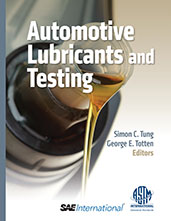Technical Paper
Surface and Tribological Characterization of Coatings for Friction and Wear Reduction
1993-10-01
932787
The tribological characteristics of three different coated steel plates are compared to a bare steel plate. Coatings included a Ag/Mo coating, and two tungsten disulfide-based coatings. These materials are being considered as alternatives to bare steel and cast iron in automotive engine or powertrain components such as engine cylinders, bearings, and gears. In order to understand their tribological behavior, these coatings have been characterized in terms of surface coating properties, wear resistance, and lubricant interaction between the coating and the additive package in a test grease. Cameron-Plint test results show that the plates coated with Ag/Mo, and both tungsten disulfide-based materials all have lower friction and better wear resistance compared with the bare steel plate. Tungsten disulfide and Ag/Mo-coated plates appear to interact with grease additives. In some cases these specimens formed antiwear films.

